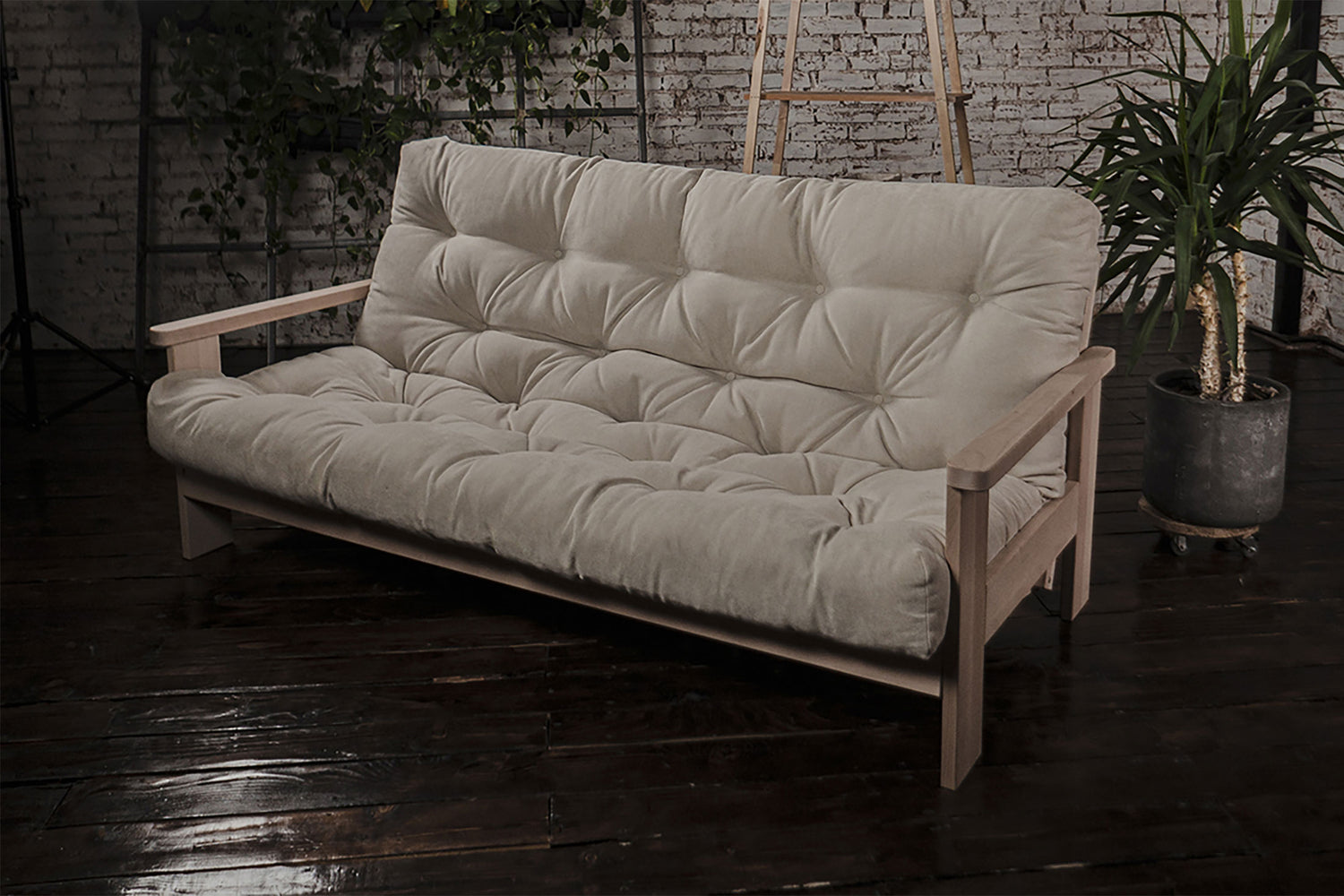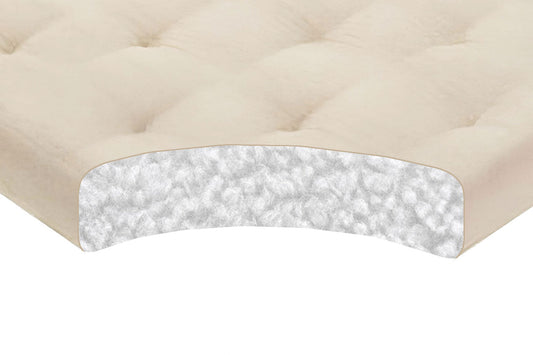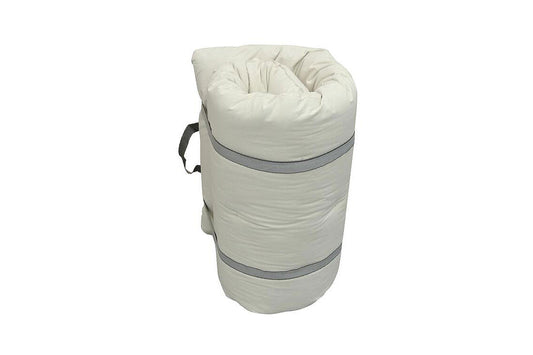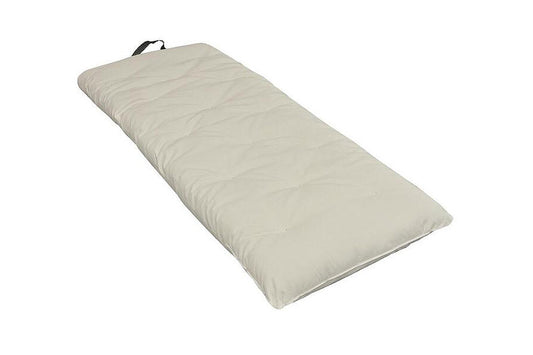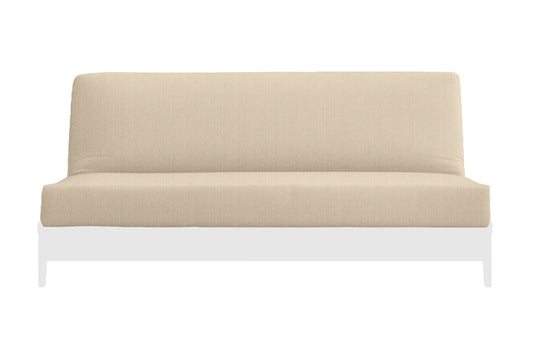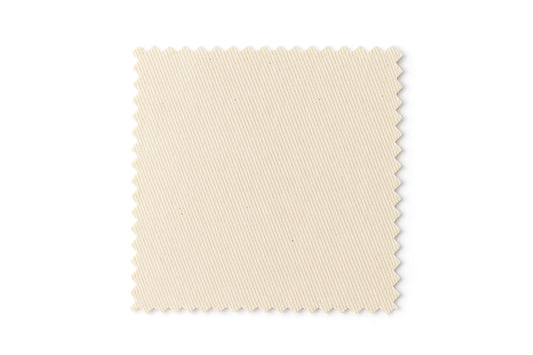
Wood Bed Frame Guide: Choosing the Right Wood for Platform Beds and Futons
Share
A bed frame or futon base is more than just a platform for your mattress. The material underneath you affects how stable the bed feels, how long it lasts, and how healthy your bedroom is over time. Soft, low-cost materials and engineered boards can flex, squeak, or sag, while a true hardwood bed frame feels solid, quiet, and reassuring every night.
This guide walks through the most common materials used in platform beds, futon frames, and natural tri-fold futons, and explains why we focus on solid beech and American oak in our collections.

Why Species Matters
Every species has its own density, strength, and grain pattern. For a wood bed frame or wood frame sofa, that translates into how much weight it can carry without bowing, whether joints stay tight or start to wobble, and how resistant it is to daily wear. It also affects how much glue, filler, or engineered material is needed to hold everything together.
Hardwoods like beech and oak create a more durable, stable base for long-term sleep than softwoods like pine or engineered materials like particle board. If you want a wood futon with mattress or a japanese futon bed you can use nightly, the species of the frame matters as much as the mattress itself.
Materials You’ll See in Natural Tri-Fold Futons and Beds
When you look at popular natural tri-fold futons, budget futon frames, and platform beds, you’ll see the same few options appear again and again.
Pine is one of the most common choices in entry-level futon frames and basic platform bases. It keeps prices low and is easy to work with, but it is a soft material that dents and scratches easily. Knots and sap pockets can weaken boards, and pine slats tend to flex more over time, which can lead to sagging under a heavier mattress.
Poplar is sometimes marketed as an upgrade, and technically it is a hardwood. In practice, it is still relatively soft and light. Poplar is often used in hidden parts of a frame rather than in the visible rails that carry most of the load. As a structural species for a daily-use bed, it does not match the stability or strength of dense beech or American oak.
Mid-range hardwoods like rubberwood, birch, and maple appear in many futon frames, platform beds, and hardwood frame sofa designs. These species are a step up from pine and poplar and can be perfectly serviceable for daily use. They offer better density and strength and are often used in laminated or finger-jointed form. If you are moving up from basic softwood frames, these can be a reasonable middle ground.
Particle board and MDF sit at the opposite end of the spectrum from true hardwood. Many products advertised as a “wood bed frame” quietly rely on a composite core covered with a thin veneer. These boards are made from fibers and glue, not solid lumber. They are more prone to sagging, chipping, and swelling with moisture, and are difficult to repair if corners blow out or screws strip. They also often involve strong adhesives and finishes you may not want in a low-tox bedroom. For any futon, platform bed, or Japanese-style bed you plan to sleep on nightly, particle board is best avoided.
In short, pine, poplar, and engineered boards may be acceptable for occasional guest use, but they are not what we consider ideal for long-term, everyday sleep.

Why We Rely on Beech
Beech is the quiet hero of European furniture making, and it is at the heart of our Beechwood Collection. This tight-grained hardwood is dense and strong, with a fine, even texture that makes it ideal for structural rails and slats in a platform bed or futon frame.
Because beech is naturally stable, it helps frames stay solid and squeak-free over time. The even grain resists splintering and takes a smooth, natural oil finish, which is important if you are building a calm, low-tox bedroom. In a beech platform with a wood futon frame or Japanese futon bed setup, the weight of the mattress and sleeper is distributed evenly across strong slats and rails. This is especially important for natural futon mattresses, shikibutons, and latex or wool mattresses that need consistent, breathable support.
American Oak for Heirloom-Level Frames
American oak brings a different personality to a hardwood bed frame. It has a distinctive grain and a long history in classic, heirloom furniture. In our Amish furniture collection, solid American oak is used to build futon sofa bases with a focus on longevity.
Oak is exceptionally strong and stiff. An oak futon frame with a mattress feels as substantial as a conventional bed and is well-suited to daily sitting and sleeping. The visible grain can lean rustic or modern, depending on the finish and fabric you pair it with, which makes oak a flexible choice for many interiors.
If you want a frame that can handle kids climbing, guests visiting, and room rearrangements over the years, American oak is a reliable, time-tested option.

Japanese-Style Beds and “Thuma-Style” Platforms
Low, minimalist beds inspired by Japanese interiors have become a category of their own. Whether someone is searching for a Thuma-style platform or a Japanese-inspired bed, what they’re really looking for is the same thing: a simple, low hardwood base that lets the mattress and natural bedding breathe.
In our collection, several designs give you that calm, grounded look without relying on softwoods or particle board.
- The Kawasaki Natural Platform Bed is a low-profile beech frame with clean, straight lines that work beautifully in small spaces and minimalist rooms.
- The Osaka Natural Platform Bed offers a similar silhouette with subtle details that soften the look while keeping the structure fully in solid beech.
- Similar to popular Japanese-style platforms, our Tatami Bed offers the same simple, grounded look in solid hardwood. It is a solid beech platform designed to work with tatami mats, natural futon mattresses, or a shikibuton, giving you an authentic Japanese bed frame feel in a modern bedroom.
Pairing these bases with a natural futon or shikibuton creates a true Japanese futon bed experience: close to the floor, breathable, and free from particle board and heavy chemical finishes.
How to Choose the Right Hardwood Frame
As you compare options—whether you are shopping for a wood bed frame, a hardwood bed frame for nightly sleep, or a wood frame sofa that converts to a futon—focus on a few core questions.
First, ask whether it is truly solid. Look for clear mentions of beech, American oak, or other named hardwoods, rather than vague terms like “wood products”, “composite core”, or “engineered wood”. If you see pine, poplar, particle board, or MDF as the main structure, you are looking at a shorter expected lifespan.
Second, look beyond the visible surfaces. Drawer fronts might be hardwood, while drawer bottoms are particle board; side rails might be solid, while center supports are not. A genuinely natural, hardwood frame will be upfront about materials in both the visible and functional components.
Third, pay attention to the finish. A natural oil finish on a beech or oak platform keeps the material breathable and complements a low-tox bedroom. A heavily sealed, high-gloss finish on engineered board is a different category entirely.
Finally, ask whether the frame is designed for real sleep or occasional sitting. A frame that will be used every night should have strong slats, tight joinery, and hardwood throughout the structure, whether it is a futon, a Japanese-style bed, or a conventional platform.
If you want to explore solid hardwood options across the full range—from minimalist Japanese bed frame designs to classic, higher-profile platforms—take a look at our platform beds collection. A well-made hardwood frame becomes a long-term part of your home, giving both your mattress and your body the support they need, night after night.








